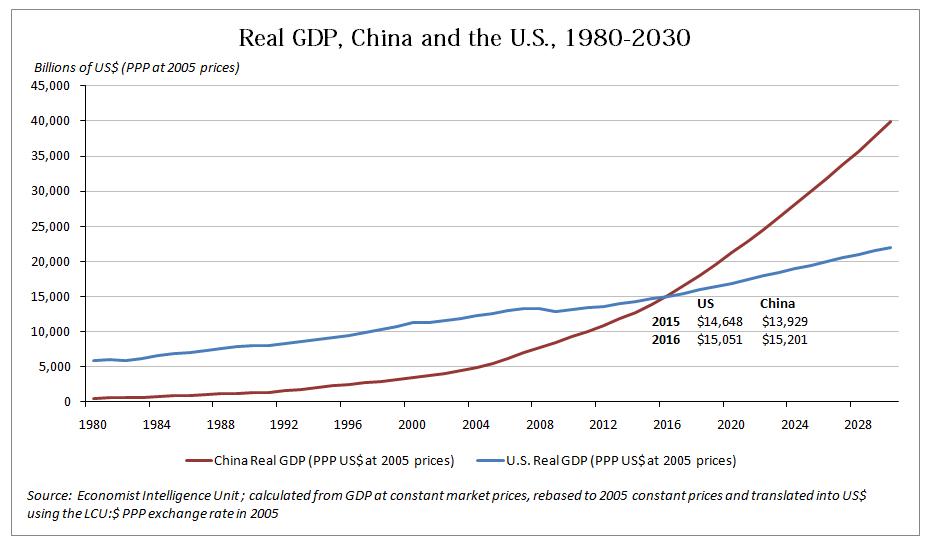
China’s economy to overtake US in next four years, says OECD. China’s economy will be biggest in world by end of 2016, says leading international thinktank.
IMO 2016 is too optimistic, better say 2022 is more possible.
Let’s do a small calculation:
In 2011:
China’s real GDP (according to exchange rate of 1 USD = 6.2 Chinese Yuan) is: 7500 billion USD.
China’s PPP (purchasing power) is: 11300 USD
USA’s real GDP is: 15000 USD.
Source: CIA Factbook
So in 2011, China’s economy is 75% of that USA.
China has an average of 8% year growth, so this seems well possible that in 2016 China might overtake USA to be #1 economy im the world.NOTE: Indeed PPP is much more accurate to value a country’s local economy, because in real life, one USD can buy far more goods in China than in America.
Then in military terms:
USA spends about 600 billion USD on military, China only spends about 120 billion USD in defense.
But China only spends about 1.5% of the GDP in defense, while USA spends some 4% on it. So anytime, when China wants, it can increase the military spending to catch up that of USA.
China will overtake the US in the next four years to become the largest economy in the world, says a leading international thinktank.
The Paris-based Organisation for Economic Co-operation and Development (OECD) said China’s economy will be larger than the combined economies of the eurozone countries by the end of this year, and will overtake the US by the end of 2016.
Global GDP will grow by 3% a year over the next 50 years, it says, but there will be large variations between countries and regions. By 2025, it says the combined GDP of China and India will be bigger than that of France, Germany, Italy, Japan, UK, US and Canada put together. Asa Johansson, senior economist at the OECD, said: “It is quite a shift in the balance of economic power we are going to see in the future.”
Inequalities will persist, even though people in the poorest countries will see their income more than quadruple by 2060, with those in China and India seeing a more than a seven-fold increase. By 2060, the OECD says living standards in the emerging countries will still only be 25%-60% of the level enjoyed by those in the US.
Global imbalances, which created the conditions for the crash of 2007, will continue to widen and reach pre-crisis levels by 2030, it said. In the short term, this is largely a cyclical effect of the financial crisis. So the US, which had a large budget deficit before the crisis, experienced a sharper downturn than China, which had a budget surplus.
The OECD warned that rising imbalances could undermine growth. But, it said, if countries undertook more ambitious reforms with regards to labour and production, they could be reduced. Johansson said these could address how easy it was to hire and fire employees, or regulations around starting up a business and restrictions over foreign business investment.




America can beat your daddy up Jim, while I appreciate your flag waving it is time to look at what continues to be our White Elephant, national defense. We our spending over $1 Trillion dollars a year on our military and our two wars in Mid Asia. What has it accomplished? It has drained $1 Trillion dollars of our nation’s capital and high tech resources that could be better used in improving our educational system in order to produce a superior talent of employees. It could be invested into new research, engineering, capital for business expansion, to assist in seeding… Read more »
According to data from the Economist Intelligence Unit, China’s economy will be bigger than the U.S.’ in 2016. 这个发展势头原来比很多人认为的2025来得还要快,奇迹。 Will China’s Economy Overtake the U.S.’ in 2016? http://www.futureofuschinatrade.com/article/china-gdp-overtake-us-gdp-2016 By Molly Castelazo, FutureofUSChinaTrade.com Facilitator Earlier this week I set to beef up the Facts & Figures section (see more than 20 new charts and graphs). This morning I sat down to create some graphs showing GDP for the U.S. and China. It wasn’t until the graphs were done and I was ready to upload them to the website that it really hit me: these forecasts (from the Economist Intelligence Unit) say… Read more »